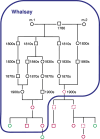Two founder variants account for over 90% of pathogenic BRCA alleles in the Orkney and Shetland Isles in Scotland
- PMID: 39438716
- PMCID: PMC11607322
- DOI: 10.1038/s41431-024-01704-w
Two founder variants account for over 90% of pathogenic BRCA alleles in the Orkney and Shetland Isles in Scotland
Abstract
For breast and ovarian cancer risk assessment in the isolated populations of the Northern Isles of Orkney and Shetland (in Scotland, UK) and their diasporas, quantifying genetically drifted BRCA1 and BRCA2 pathogenic variants is important. Two actionable variants in these genes have reached much higher frequencies than in cosmopolitan UK populations. Here, we report a BRCA2 splice acceptor variant, c.517-2A>G, found in breast and ovarian cancer families from Shetland. We investigated the frequency and origin of this variant in a population-based research cohort of people of Shetland ancestry, VIKING I. The variant segregates with female breast and ovarian cancer in diagnosed cases and is classified as pathogenic. Exome sequence data from 2108 VIKING I participants with three or more Shetlandic grandparents was used to estimate the population prevalence of c.517-2A>G in Shetlanders. Nine VIKING I research volunteers carry this variant, on a shared haplotype (carrier frequency 0.4%). This frequency is ~130-fold higher than in UK Biobank, where the small group of carriers has a different haplotype. Records of birth, marriage and death indicate genealogical linkage of VIKING I carriers to a founder from the Isle of Whalsay, Shetland, similar to our observations for the BRCA1 founder variant c.5207T>C from Westray, Orkney. In total, 93.5% of pathogenic BRCA variant carriers in Northern Isles exomes are accounted for by these two drifted variants. We thus provide the scientific evidence of an opportunity for screening people of Orcadian and Shetlandic origins for each drifted pathogenic variant, particularly women with Westray or Whalsay ancestry.
© 2024. The Author(s).
Conflict of interest statement
Competing interests: AS and GT are employees and/or stockholders of Regeneron Genetics Center or Regeneron Pharmaceuticals. LK is an employee of BioAge Labs and holds share options. For the purpose of open access, the author has applied a Creative Commons Attribution (CC BY) licence to any Author Accepted Manuscript version arising from this submission. Ethical approval: Eligible participants were recruited to ORCADES and the Viking Health Study Shetland (VIKING I), now part of Viking Genes, Research Ethics Committee reference 19/SS/0104. Research participants gave written informed consent for research procedures that included electronic health record linkage and DNA sequencing. The data linkage and access to NHS Scotland-originated data for ORCADES and VIKING I was approved by the Public Benefit and Privacy Panel for Health and Social Care (Ref 1718-0380). This research has also been conducted using data from UK Biobank, as part of project number 19655. Frequencies for the ATM and CHEK2 variants reported here, and the BRCA2 variant c.517-2A>G numbers in Table 1, were derived from the UK Biobank Whole Genome Sequencing (WGS) project and were obtained from the UK Biobank Allele Frequency Browser (afb.ukbiobank.ac.uk), which was generated by the WGS consortium under the UK Biobank Resource (project ID 52293).
Figures



References
-
- Kuchenbaecker KB, Hopper JL, Barnes DR, Phillips KA, Mooij TM, Roos-Blom MJ, et al. Risks of Breast, Ovarian, and Contralateral Breast Cancer for BRCA1 and BRCA2 Mutation Carriers. JAMA. 2017;317:2402–16. - PubMed
MeSH terms
Substances
Grants and funding
LinkOut - more resources
Full Text Sources
Medical
Miscellaneous

